Title
Mike Kelley Memory WarePosted In
ExhibitionArtist
Mike KelleyDuration
03 November 2016 to 23 December 2016Venue
Hauser & Wirth New York, 69th StreetOpening Hours
Tuesday to Saturday 10.009 – 18.00Location
| Detailed Information | |||||
|---|---|---|---|---|---|
| Title | Mike Kelley Memory Ware | Posted In | Exhibition | Artist | Mike Kelley |
| Duration | 03 November 2016 to 23 December 2016 | Venue | Hauser & Wirth New York, 69th Street | Opening Hours | Tuesday to Saturday 10.009 – 18.00 |
| Location |
32 East 69th Street New York City, NY 10021
United States | ||||

Mike Kelley, Memory Ware Flat #27, 2001. Mixed media on wood panel. 178 x 117.3 x 10 cm / 70 1/8 x 46 1/8 x 3 7/8 in. Art © Mike Kelley Foundation for the Arts. All Rights Reserved / Licensed by VAGA, New York, NY. Private Collection. Courtesy the Foundation and Hauser & Wirth. Photo by Stefan Altenburger Photography Zürich.
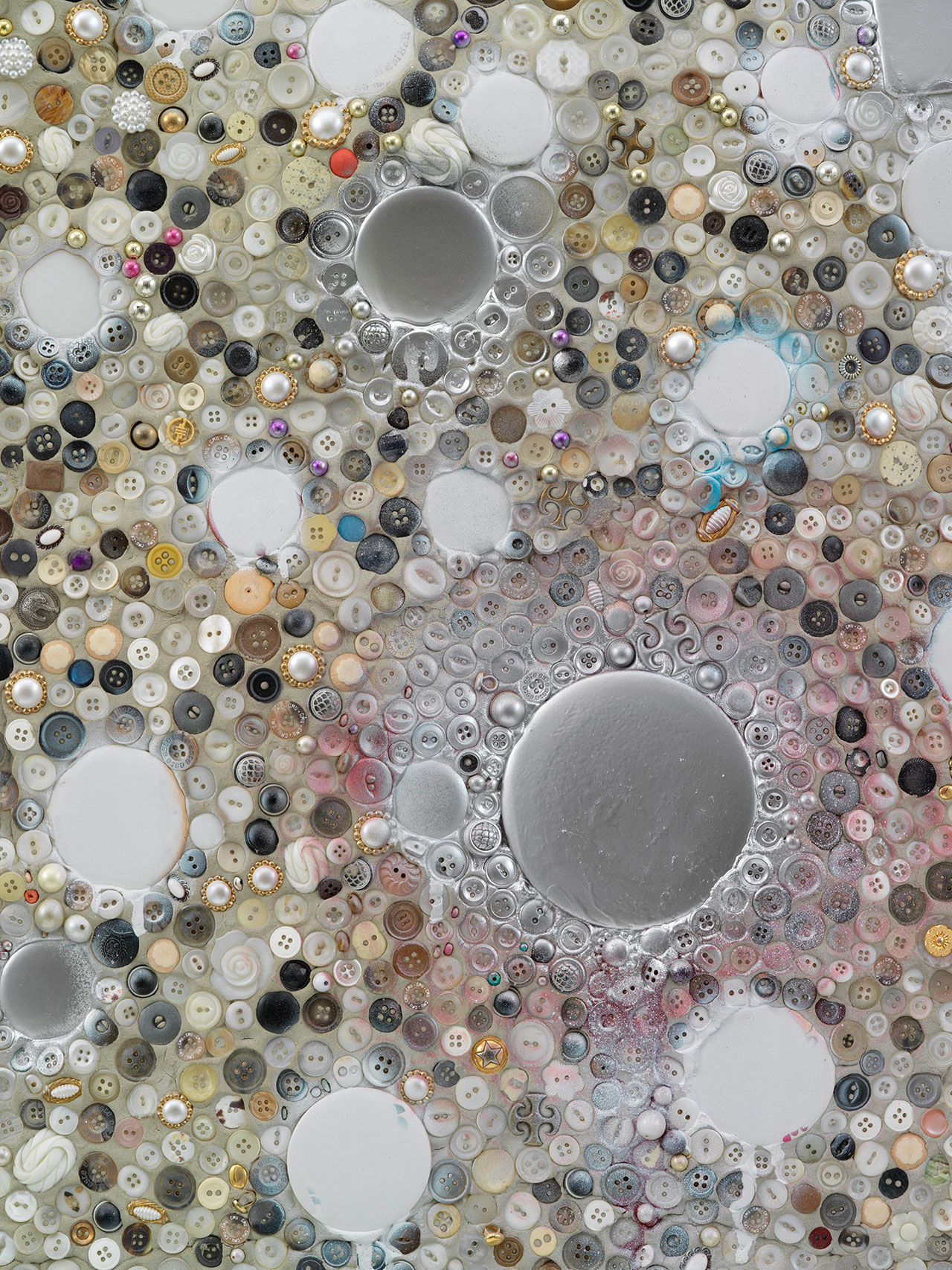
Mike Kelley, Memory Ware Flat #27 (detail), 2001. Mixed media on wood panel. 178 x 117.3 x 10 cm / 70 1/8 x 46 1/8 x 3 7/8 in. Art © Mike Kelley Foundation for the Arts. All Rights Reserved / Licensed by VAGA, New York, NY. Private Collection. Courtesy the Foundation and Hauser & Wirth. Photo by Stefan Altenburger Photography Zürich.
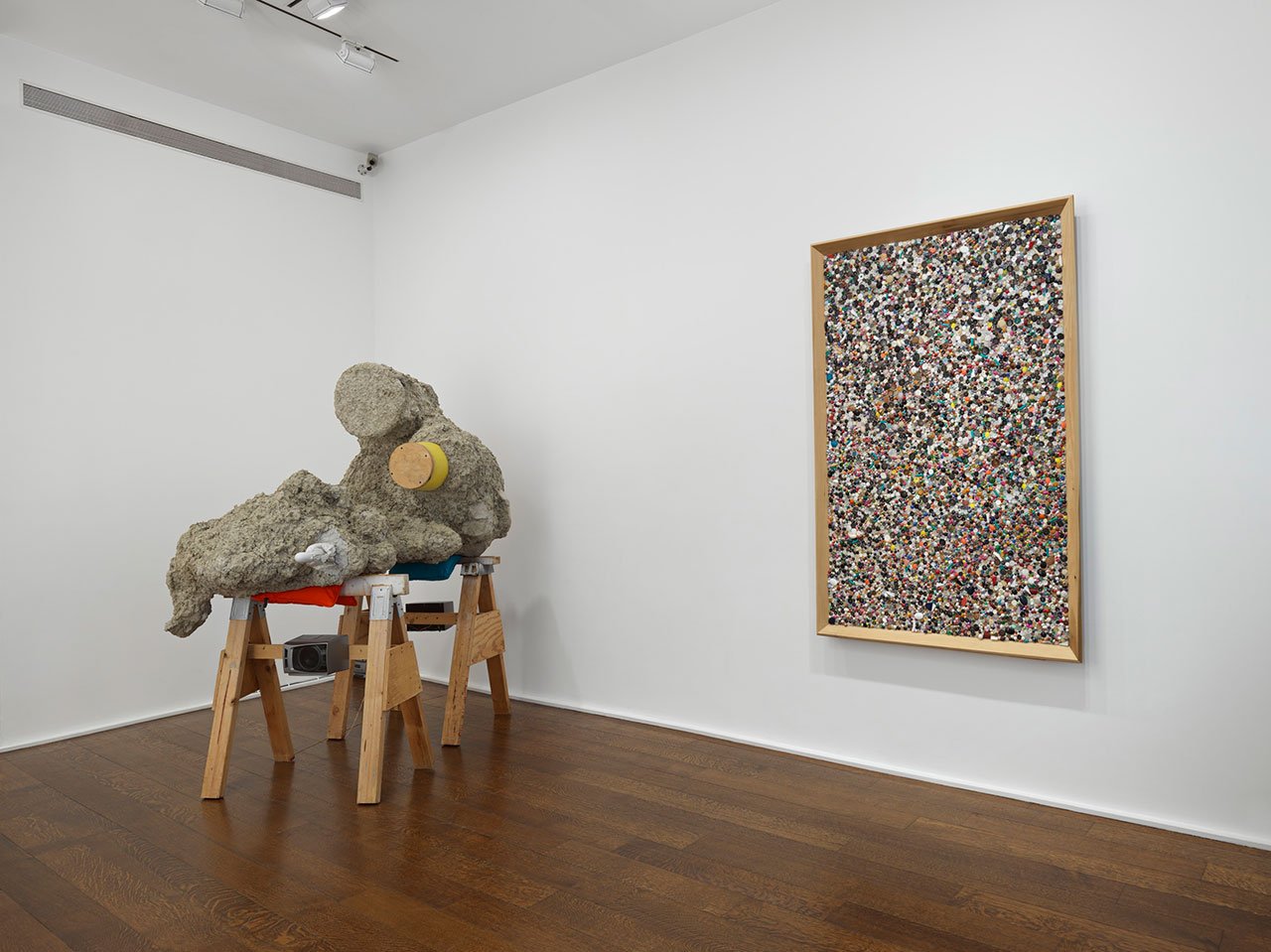
Installation view, Mike Kelley. Memory Ware, Hauser & Wirth New York, 2016. Art © Mike Kelley Foundation for the Arts. All Rights Reserved / Licensed by VAGA, New York, NY. Courtesy the Foundation and Hauser & Wirth. Photo by Genevieve Hanson.
Comprising more than 100 works created between 2000 and 2010, Kelley’s “Memory Ware” series borrows its name and aesthetics from folk art found in black communities in the American South and Victorian Britain in which bottles and other vessels were decorated with sentimental keepsakes such as buttons, beads and charms, embedded in a coating of clay. As Ralph Rugoff, director of London’s Hayward Gallery, explains “given his existing interest in remembrance and in re-purposing materials with prior histories [see for example, ‘More Love Hours Than Can Ever Be Repaid and The Wages of Sin’, one of Kelley’s most famous works from 1987 featuring a mess of used rag dolls, stuffed animals and blankets strewn across a canvas], as well as his long-term engagement with the aesthetics of craft and folk art, Kelley recognized in this find [at a Toronto antiques fair in 2000] the possibilities for developing new works that deployed the memory ware aesthetic towards very different ends”.

Mike Kelley, Memory Ware Flat #58, 2009. Mixed media on wood panel. 128.5 x 112.2 x 10.5 cm / 50 5/8 x 44 1/8 x 4 1/8 in. Art © Mike Kelley Foundation for the Arts. All Rights Reserved / Licensed by VAGA, New York, NY. Private Collection. Courtesy the Foundation and Hauser & Wirth. Photo by Stefan Altenburger Photography Zürich.
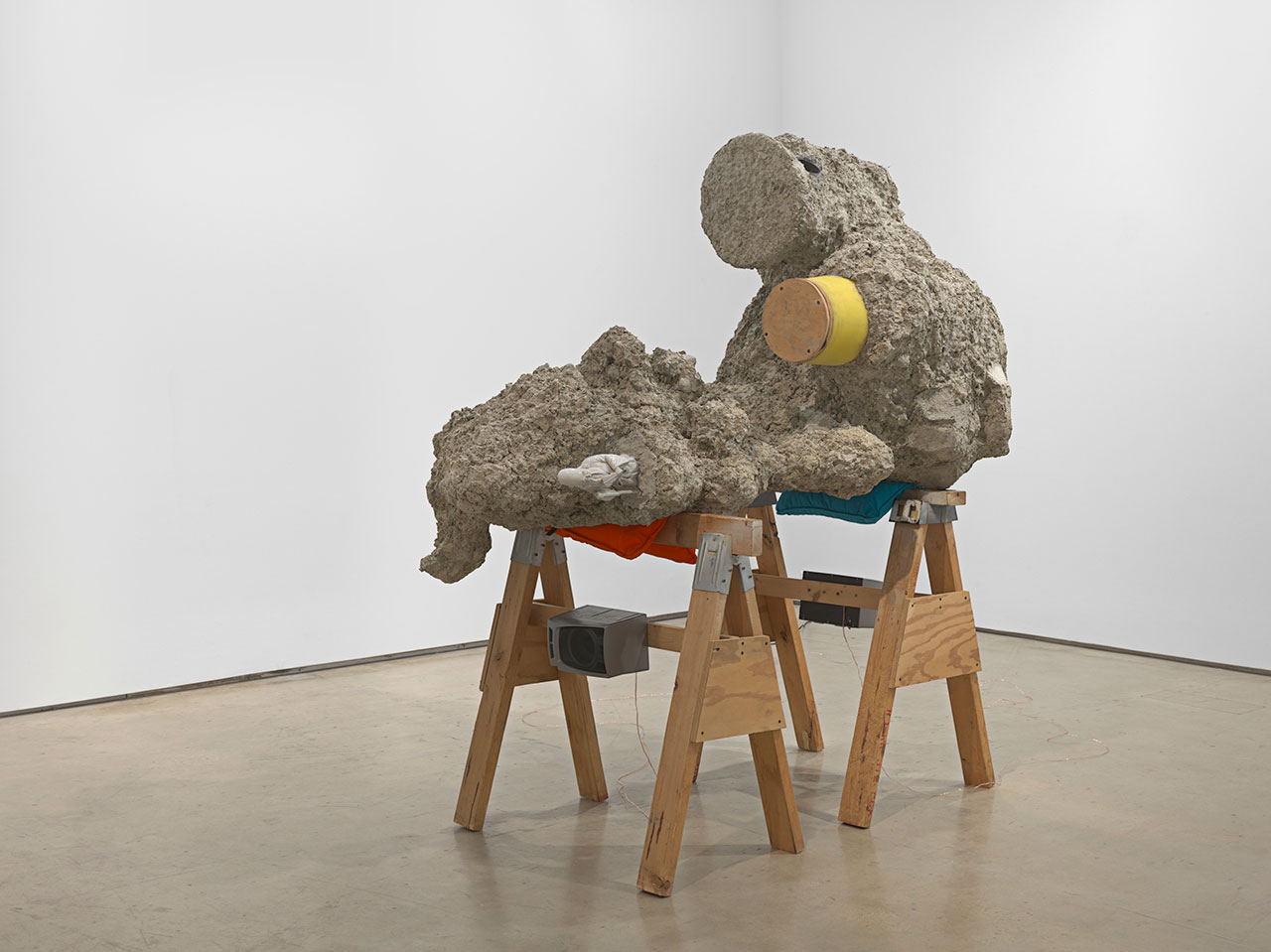
Mike Kelley, Aerodynamic Vertical to Horizontal Shift,1999. Mixed media. 194 x 116.8 x 166.4 cm / 76 3/8 x 46 x 65 1/2 inches. Art © Mike Kelley Foundation for the Arts. All Rights Reserved / Licensed by VAGA, New York, NY. Private Collection, New York. Courtesy the Foundation and Hauser & Wirth. Photo by Genevieve Hanson.
“Memory Ware Flats”, the series’ two-dimensional wall pieces on display, dazzle the viewer with their mind-boggling density made out of thousands of tchotchkes—pins, buttons, keys, coins, bottle caps, pendants and even screws, bought by the handful at thrift stores and flea markets—cemented in rectangle canvases of grey tile grout. For Kelley, memory is a stream of tiny particles, disconnected morsels of information that only sometimes add up to make clear sense.
Although from a distance, Kelley’s ‘Flats’ resemble abstract art paintings, straddling pointillism and abstract expressionism, on closer inspection, as its constituent jumble of trinkets come into focus, they almost turn into a craft project of kitsch sensibility. This perceptual shift from high to low art and vice versa which Kelley has ingeniously achieved in these works reveals his belief in the pivotal role of conventions in generating and framing different meanings but also underpins the artist’s rejection of the idealist notion that objects, including works of art, have inherent significance or value.
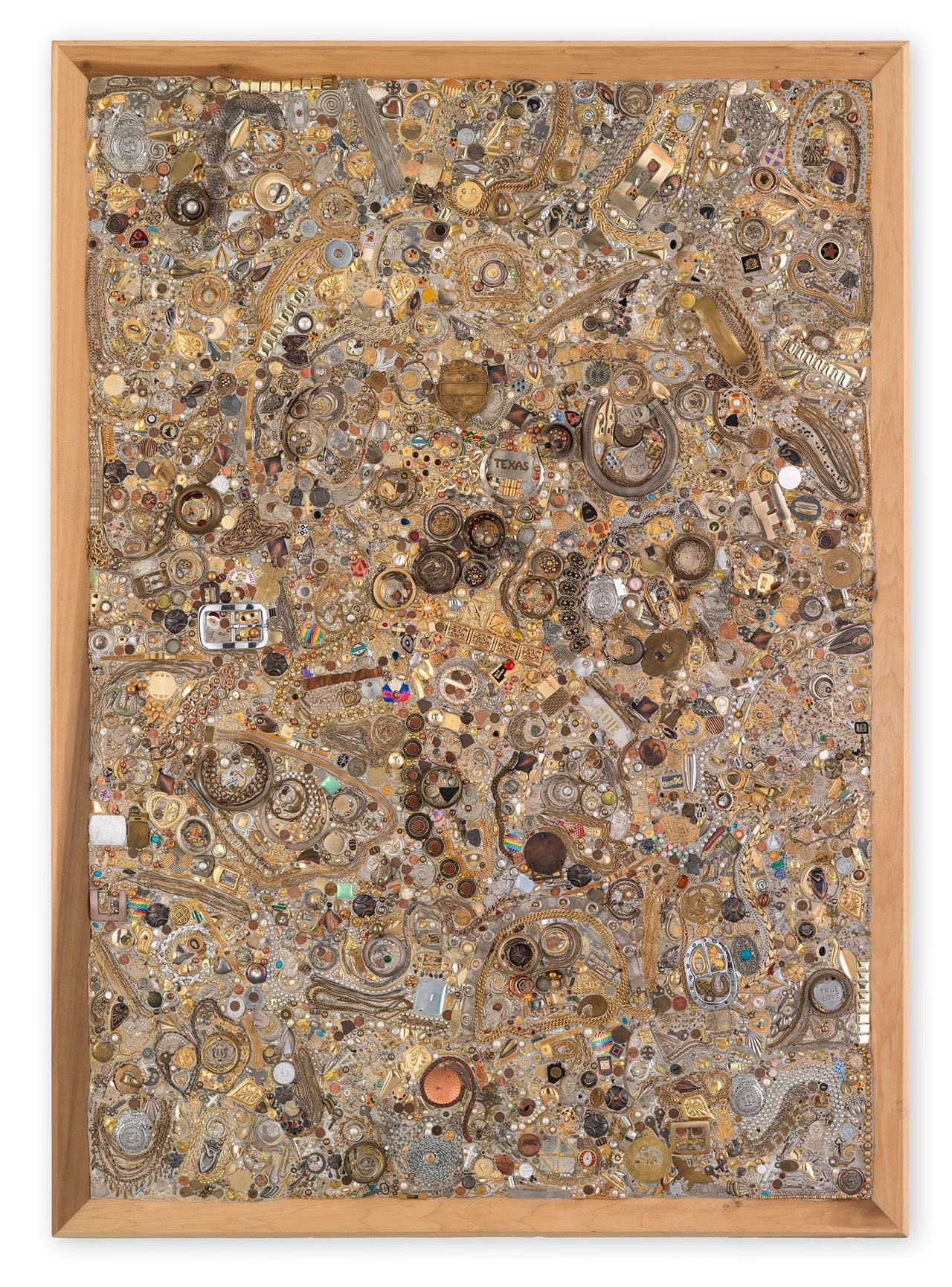
Mike Kelley, Memory Ware Flat #24, 2001. Mixed media on wood panel. 215.5 x 154 x 11.8 cm / 84 7/8 x 60 5/8 x 4 5/8 in. Art © Mike Kelley Foundation for the Arts. All Rights Reserved / Licensed by VAGA, New York, NY. Private Collection. Courtesy the Foundation and Hauser & Wirth. Photo by Stefan Altenburger Photography Zürich.
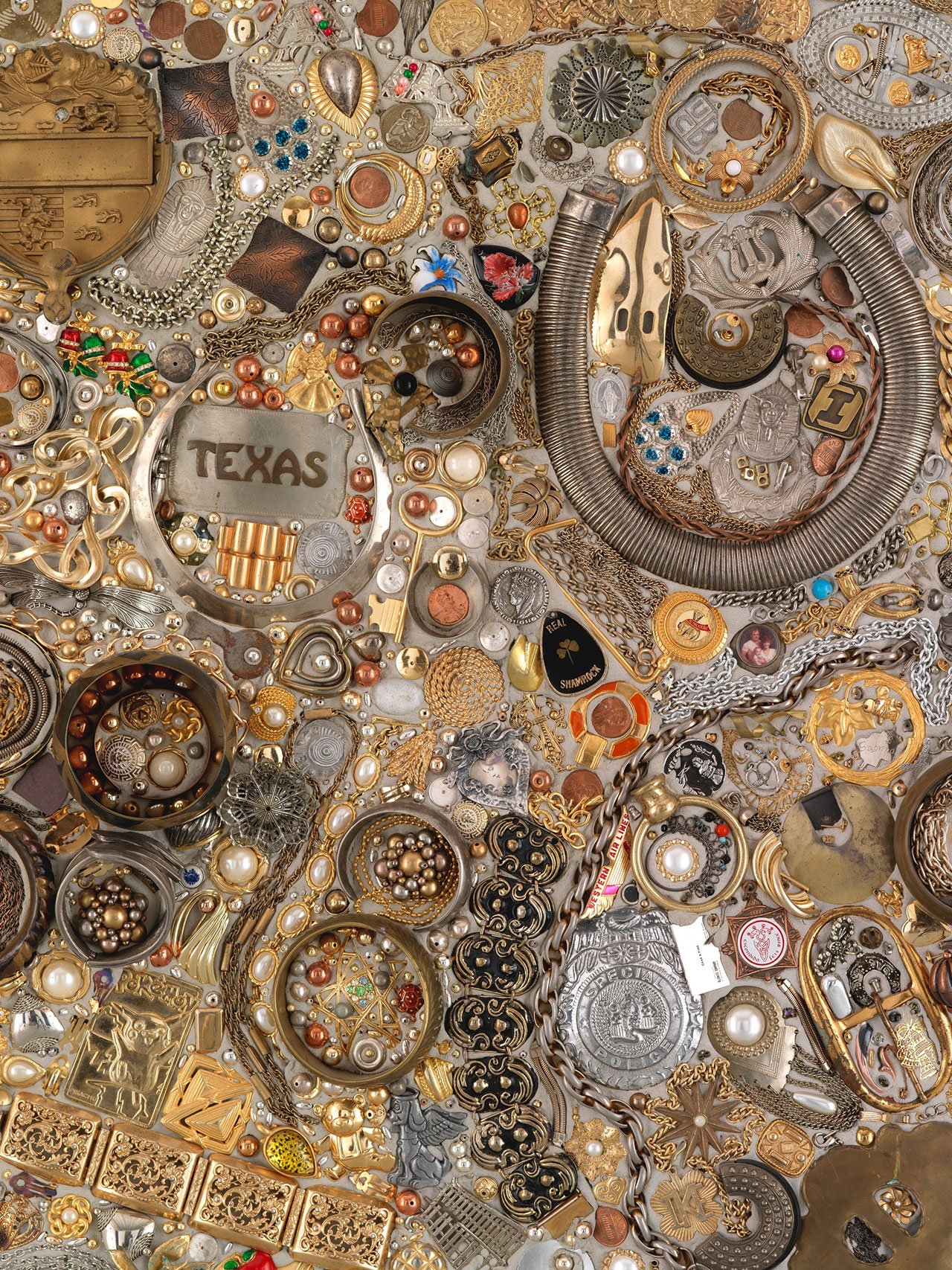
Mike Kelley, Memory Ware Flat #24 (detail), 2001. Mixed media on wood panel. 215.5 x 154 x 11.8 cm / 84 7/8 x 60 5/8 x 4 5/8 in. Art © Mike Kelley Foundation for the Arts. All Rights Reserved / Licensed by VAGA, New York, NY. Private Collection. Courtesy the Foundation and Hauser & Wirth. Photo by Stefan Altenburger Photography Zürich.
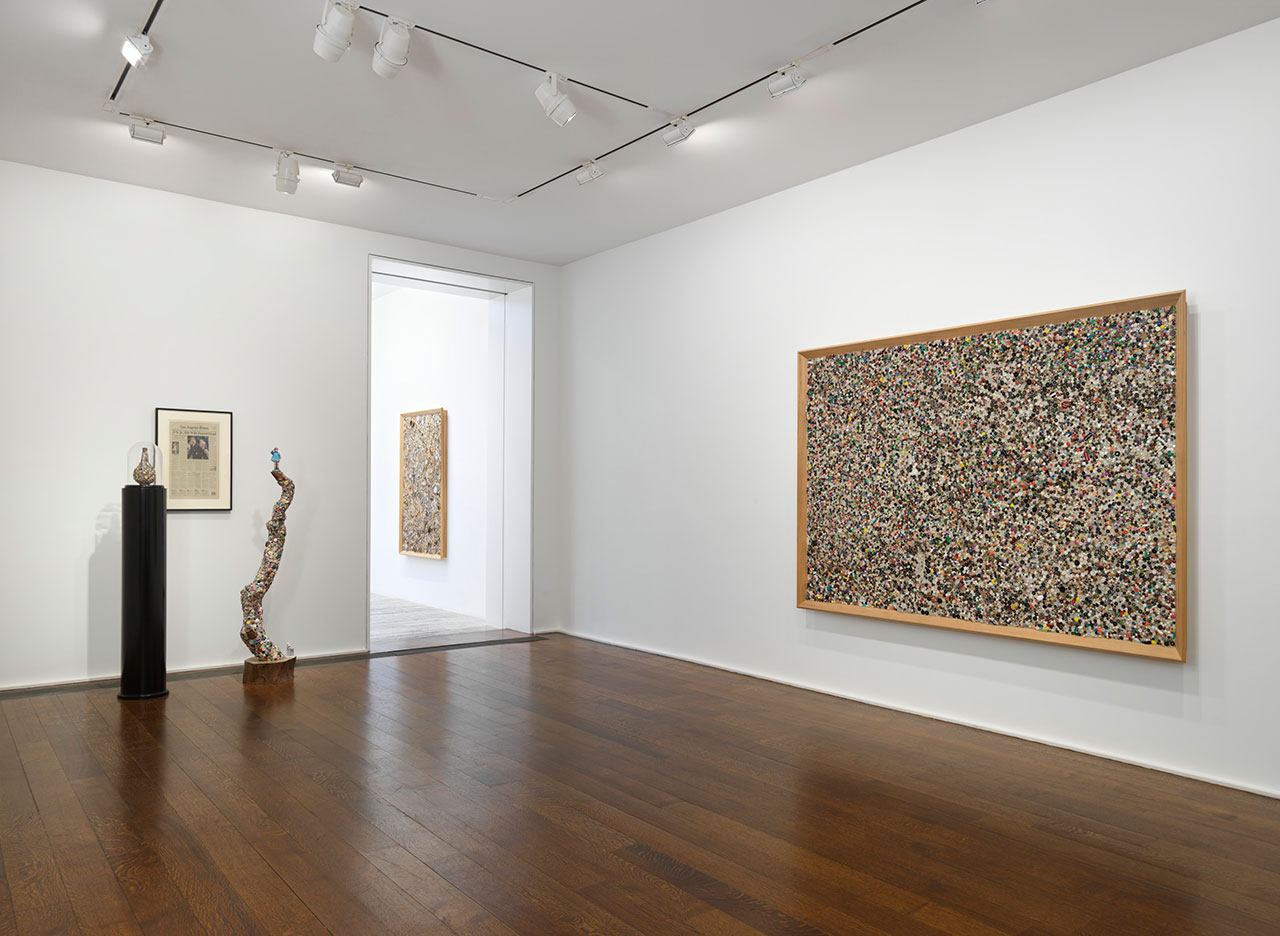
Installation view, Mike Kelley. Memory Ware, Hauser & Wirth New York, 2016. Art © Mike Kelley Foundation for the Arts. All Rights Reserved / Licensed by VAGA, New York, NY. Courtesy the Foundation and Hauser & Wirth. Photo by Genevieve Hanson.
Τhe show’s freestanding sculptures, some sharing the same mesmerizing decorative busyness as the ‘Flats’, others sporting a more minimal sensibility, provide additional layers of meaning. Take for example “In Memory of Camelot”, featuring a tiny figurine of JFK Jr. that reproduces a charged scene from his father’s funeral, a framed newspaper cover announcing his death in an airplane crash and a bejewelled urn, it entwines the deaths of father and son in the annals of our collective memory.
Quite different in conception and form but just as nuanced, “Aerodynamic vertical to horizontal shift”, a concrete blob resting on two wooden sawhorses, replicates a segment of his 1999 “Frame and frame” installation (a project that heavily informed his “Memory Ware” series), a miniature replication of the Chinatown wishing well, a 1930’s sculpture by Henry Hong Kay Liu in downtown LA that in turn is a miniature replication of the Seven Star Cave in China. Accompanied by an audio of planes taking off in order to compensate for the dynamic thrust loss from having been shifted from a vertical to a horizontal position, this third-order replica not only acknowledges the fluidity of memory but also explores the discordant relationship between meaning and form.
With an upcoming publication of a book by Hauser & Wirth Publishers documenting the entire “Memory Ware” series, there hasn’t been a more fruitful time to showcase Kelley’s superb craftsmanship, mastery in composition and conceptual ingenuity but above all his willingness to use these talents to subvert our perception of both artistic norms and his own work as an artist.

Installation view, Mike Kelley. Memory Ware, Hauser & Wirth New York, 2016. Art © Mike Kelley Foundation for the Arts. All Rights Reserved / Licensed by VAGA, New York, NY. Courtesy the Foundation and Hauser & Wirth. Photo by Genevieve Hanson.
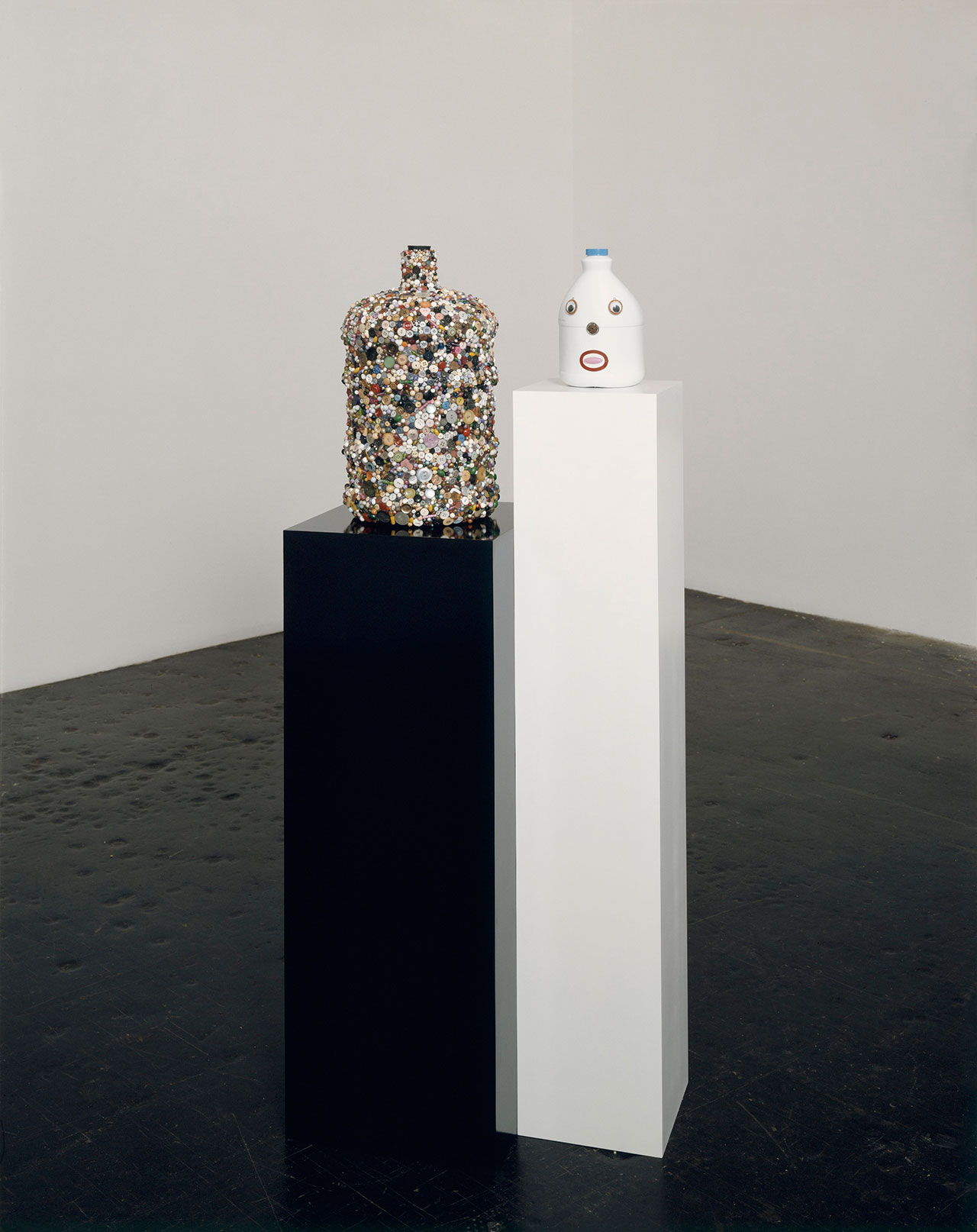
Mike Kelley, Balanced by Mass and Personification, 2001. Mixed media. 153.7 x 63.5 x 38.1 cm / 60 1/2 x 25 x 15 in. Art © Mike Kelley Foundation for the Arts. All Rights Reserved / Licensed by VAGA, New York, NY. Collection of Margaret and Daniel S. Loeb. Courtesy the Foundation and Hauser & Wirth. Photo by Nic Tenwiggenhorn, Düsseldorf.
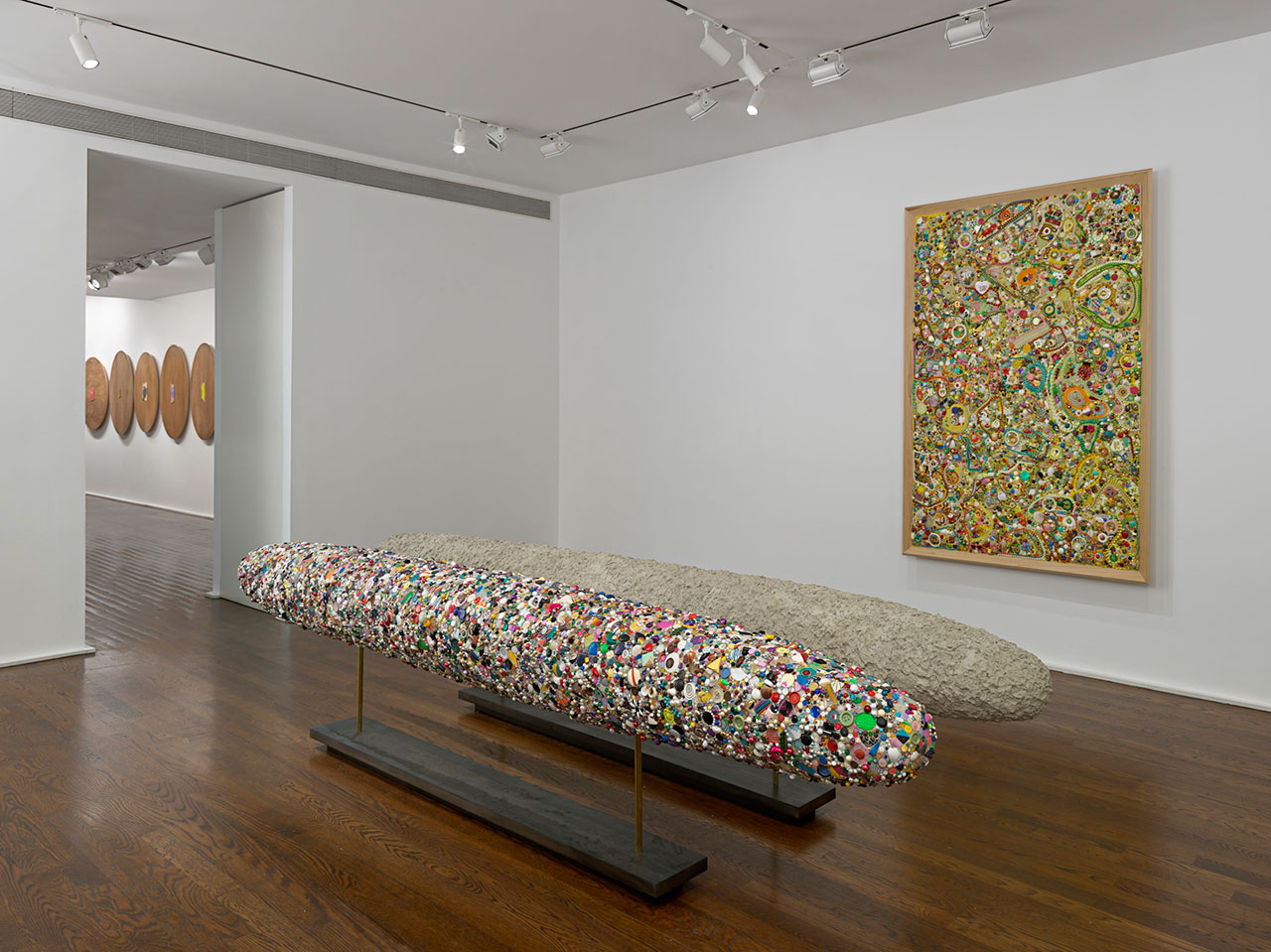
Installation view, Mike Kelley. Memory Ware, Hauser & Wirth New York, 2016. Art © Mike Kelley Foundation for the Arts. All Rights Reserved / Licensed by VAGA, New York, NY. Courtesy the Foundation and Hauser & Wirth. Photo by Genevieve Hanson.

Mike Kelley, Balanced by Mass and Worth, 2001. Plastic, foam, epoxy, painted wood, miscellaneous beads and buttons. 68.6 x 340.4 x 38.1 cm / 27 x 134 x 15 in. Art © Mike Kelley Foundation for the Arts. All Rights Reserved / Licensed by VAGA, New York, NY. Collection of Margaret and Daniel S. Loeb. Courtesy the Foundation and Hauser & Wirth. Photo by Nic Tenwiggenhorn, Düsseldorf.
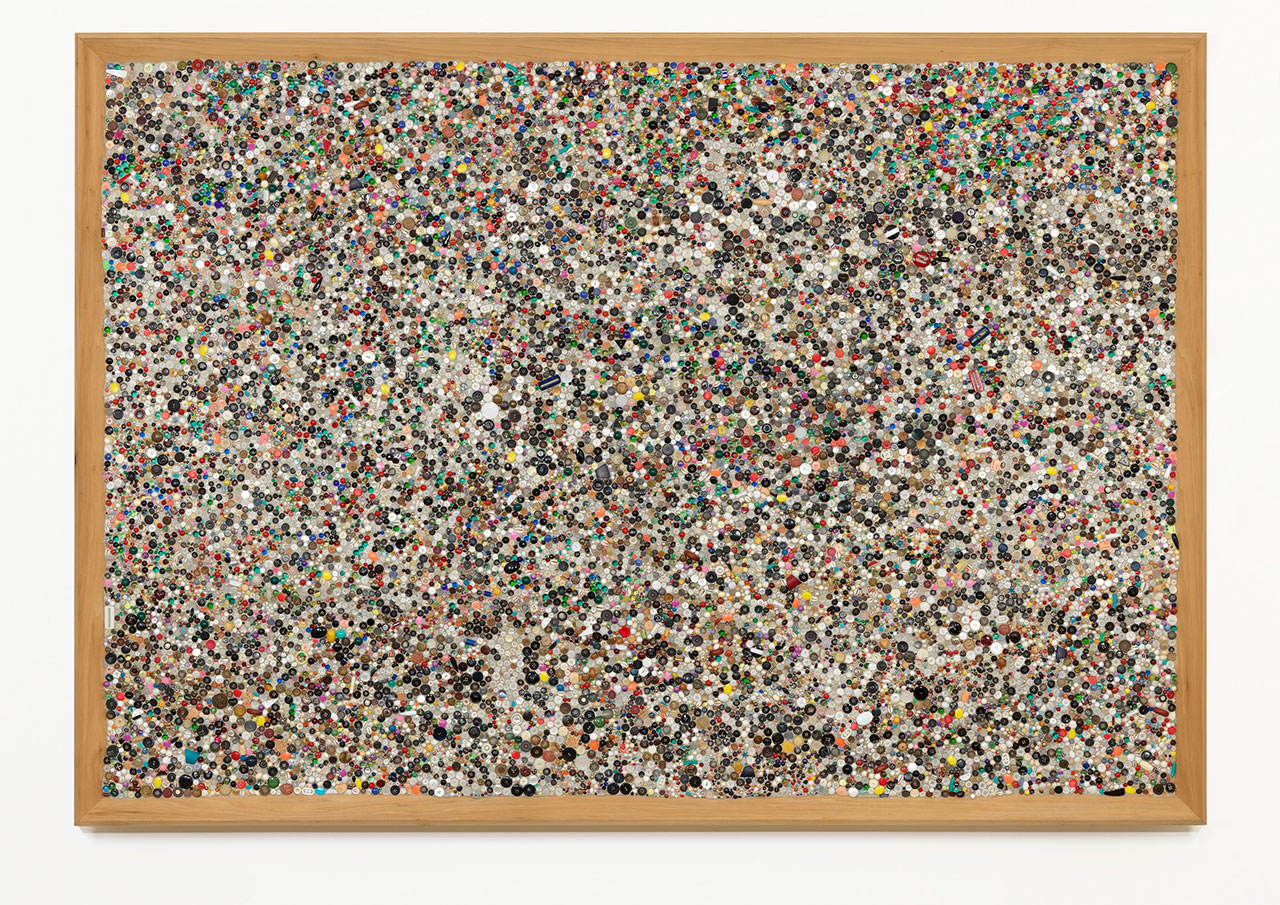
Mike Kelley, Memory Ware Flat #15, 2001. Mixed media on wood panel. 179.7 x 257 x 13.5 cm / 70 3/4 x 101 1/8 x 5 3/8 in. Art © Mike Kelley Foundation for the Arts. All Rights Reserved / Licensed by VAGA, New York, NY. Private Collection. Courtesy the Foundation and Hauser & Wirth. Photo by Andrew Smart, AC Cooper LTD.
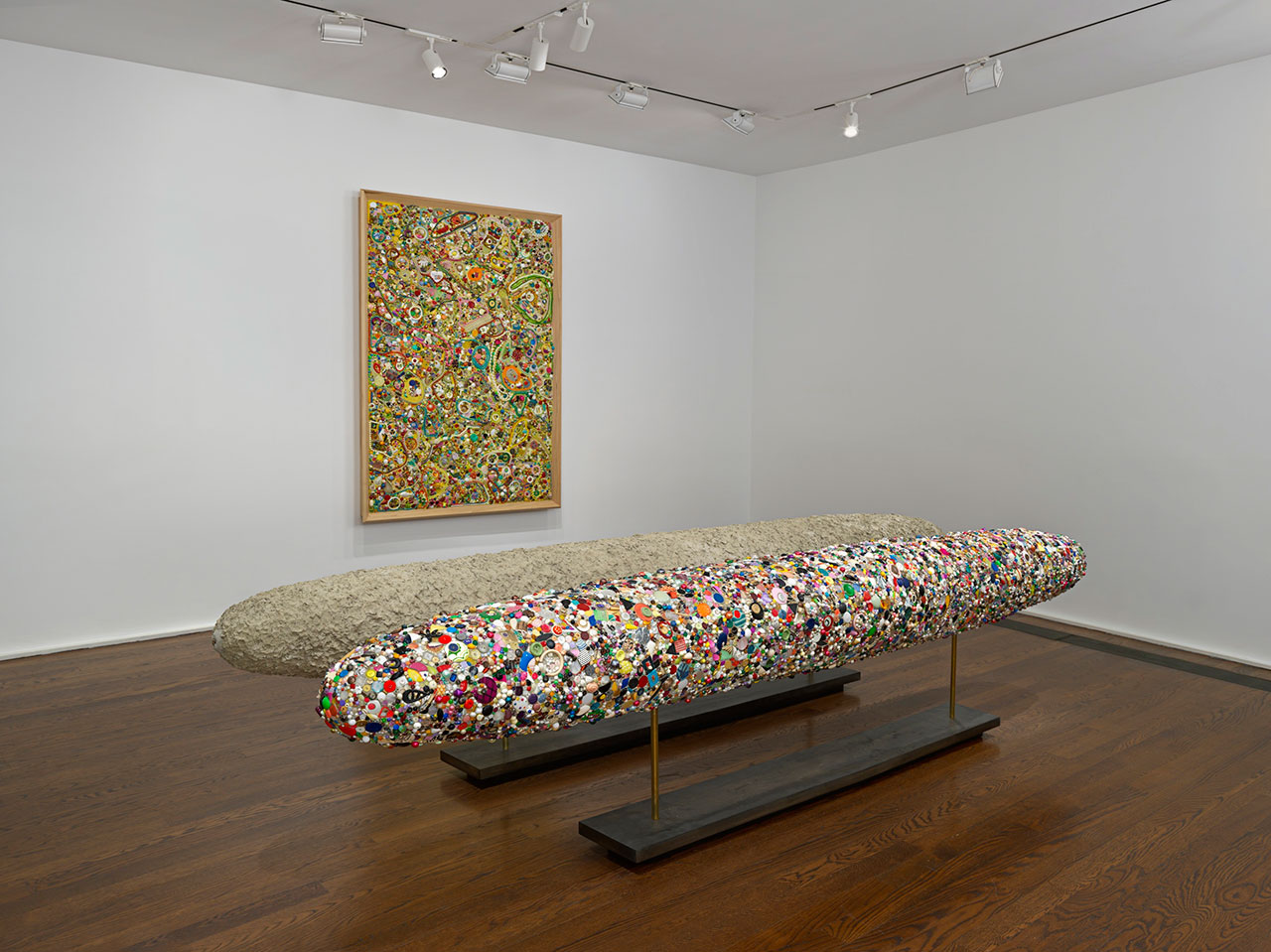
Installation view, Mike Kelley. Memory Ware, Hauser & Wirth New York, 2016. Art © Mike Kelley Foundation for the Arts. All Rights Reserved / Licensed by VAGA, New York, NY. Courtesy the Foundation and Hauser & Wirth. Photo by Genevieve Hanson.

Installation view, Mike Kelley. Memory Ware, Hauser & Wirth New York, 2016. Art © Mike Kelley Foundation for the Arts. All Rights Reserved / Licensed by VAGA, New York, NY. Courtesy the Foundation and Hauser & Wirth. Photo by Genevieve Hanson.
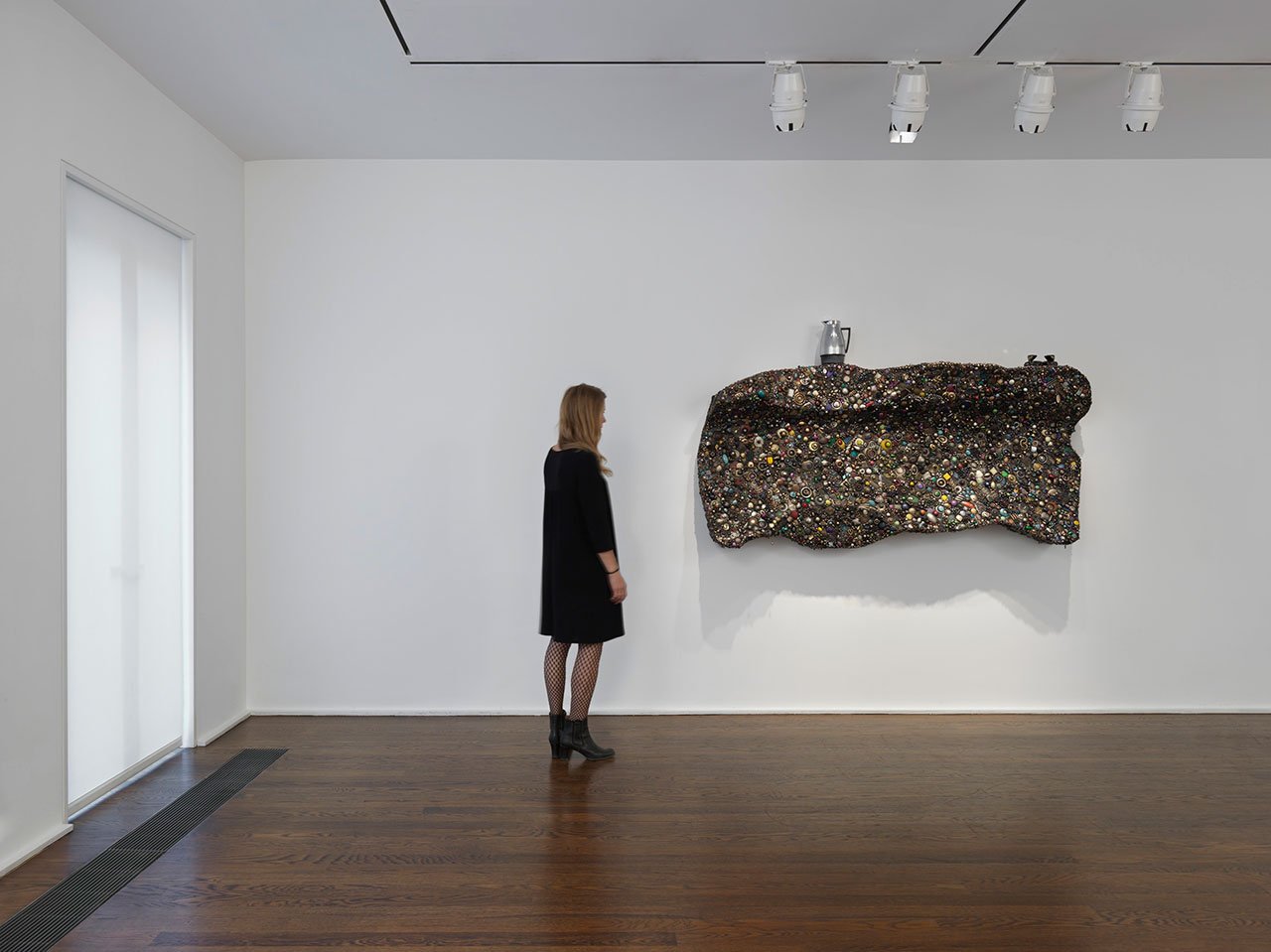
Installation view, Mike Kelley. Memory Ware, Hauser & Wirth New York, 2016. Art © Mike Kelley Foundation for the Arts. All Rights Reserved / Licensed by VAGA, New York, NY. Courtesy the Foundation and Hauser & Wirth. Photo by Genevieve Hanson.
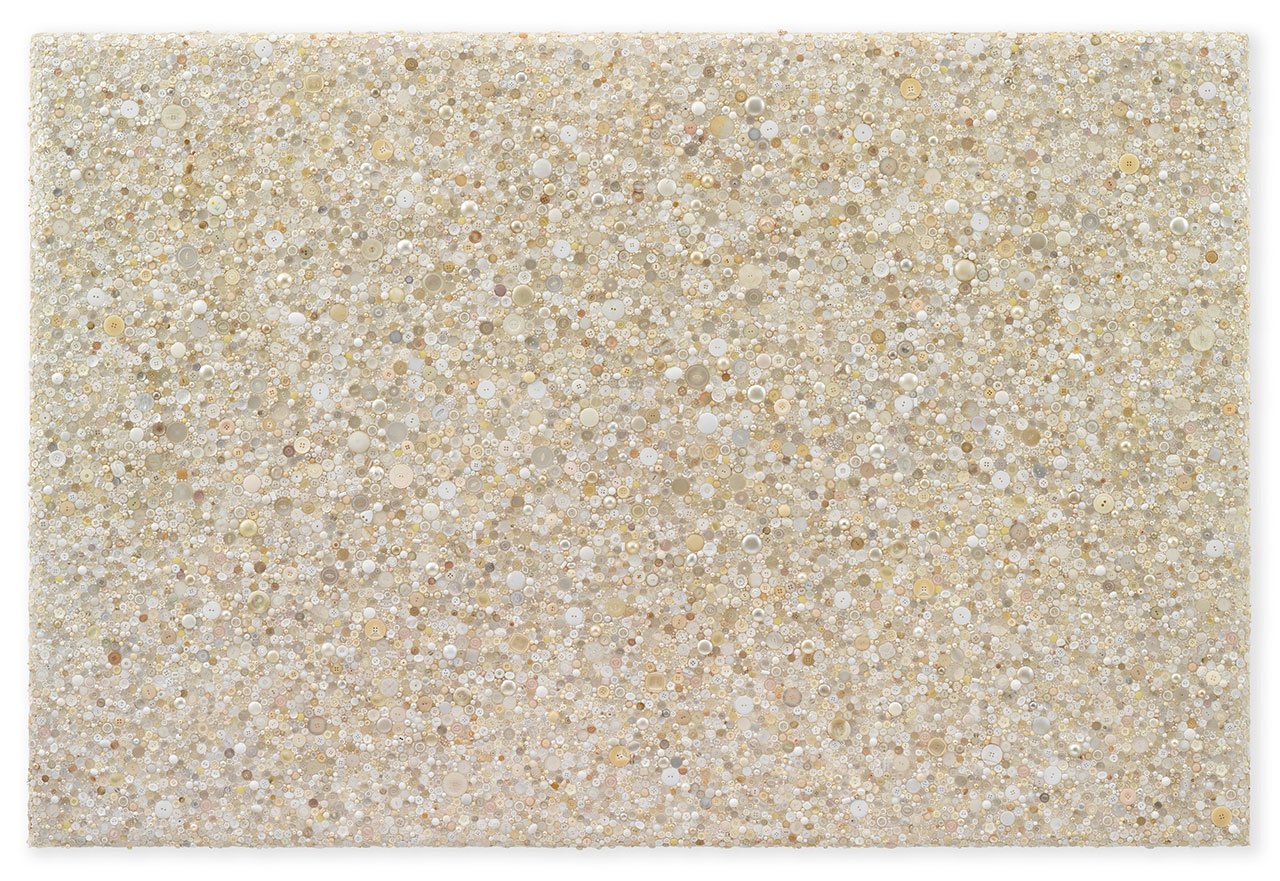
Mike Kelley, Memory Ware Flat #46, 2008. Mixed media on wood panel. 123.2 x 184.2 x 7 cm / 48 1/2 x 72 1/2 x 2 3/4 in. Art © Mike Kelley Foundation for the Arts. All Rights Reserved / Licensed by VAGA, New York, NY. Private Collection. Courtesy the Foundation and Hauser & Wirth. Photo by Stefan Altenburger Photography Zürich.
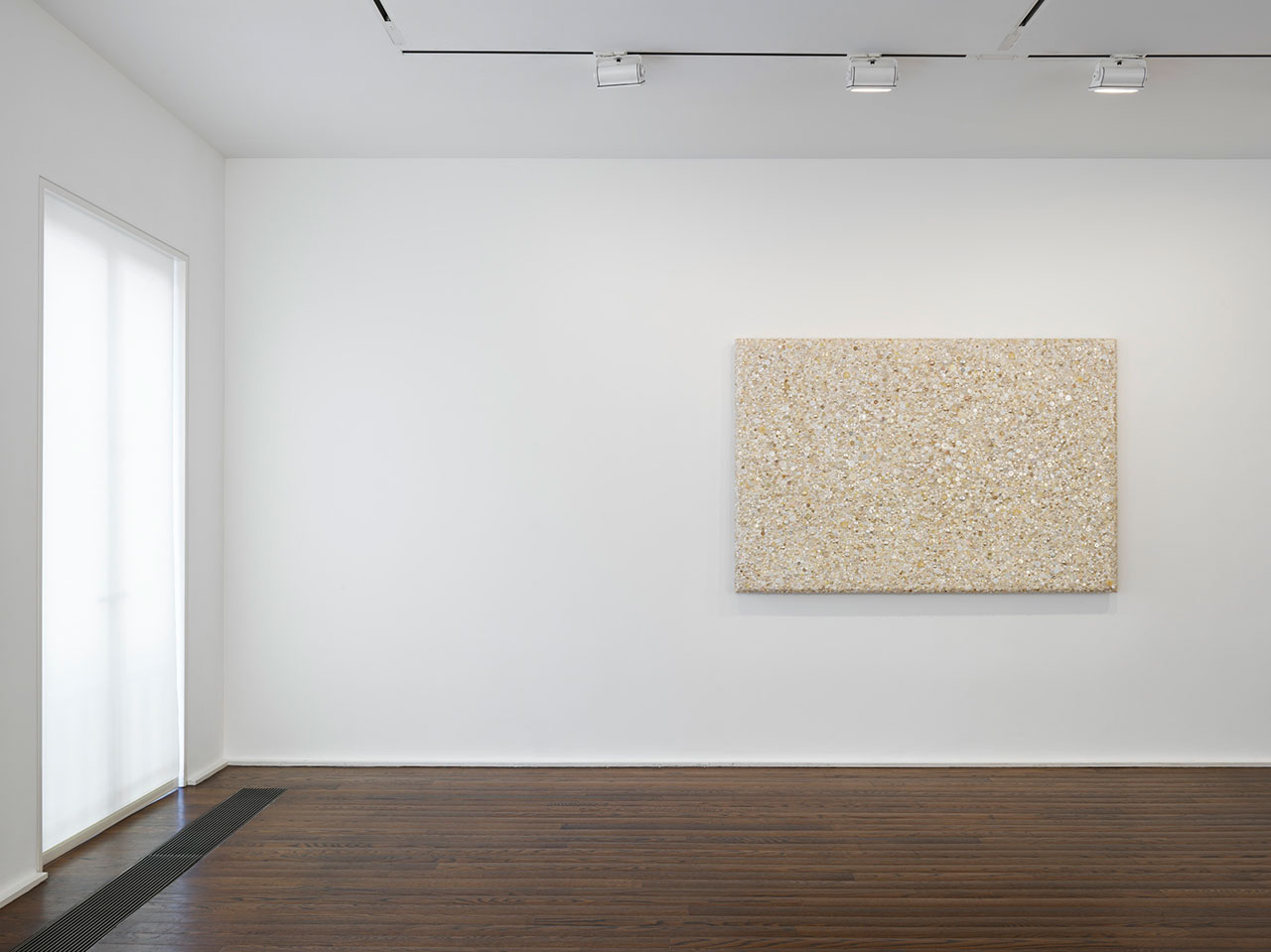
Installation view, Mike Kelley. Memory Ware, Hauser & Wirth New York, 2016. Art © Mike Kelley Foundation for the Arts. All Rights Reserved / Licensed by VAGA, New York, NY. Courtesy the Foundation and Hauser & Wirth. Photo by Genevieve Hanson.














